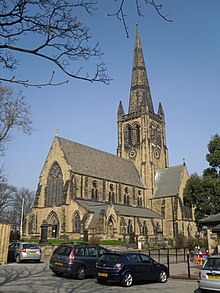User:Brigidbradley/sandbox
| Trinity Church, Ossett | |
|---|---|
 | |
| Denomination | Church of England |
| Churchmanship | Evangelical |
| Website | [1] |
| Administration | |
| Province | Province of |
| Diocese | Diocese of Wakefield |
| Archdeaconry | Pontefract |
| Deanery | Dewsbury |
| Parish | Ossett and Gawthorpe |
| Clergy | |
| Vicar(s) | Canon Paul Maybury |
The parish Church of the Holy and Undivided Trinity Ossett is perhaps most famous for its soaring church spire, one of the highest in Yorkshire. It is largely known as Trinity Church as is home to a thriving Christian community of XXX. It is a Grade II* listed building. Its current vicar is Canon Paul Maybury….
Mission and governance[edit]
History[edit]
Churches in Ossett can be traced back to the 15th century when a chapel of ease was licensed in 1409. Its first notable parish church was built in 1806 by the Rev Kilvington to account for a growing population and was located in the Market Square. At this time, Ossett was a coal mining village with largely a handloom industry but as the industrial revolution helped grow many towns and villages in Yorkshire, Ossett, by the 1840s had become a key location for the mungo and shoddy industry – marking it firmly on the map. Both its population and prosperity soared and as befitted a ‘new’ town such as this, a new church was demanded by the locals, and duly built. 1862 saw the laying of the stone for Trinity Church, Church Street Ossett, next to which there was already an existing graveyard. The church was built with the financial assistance of local resident Sir Benjamin Ingham, British consul in Sicily and completed in 1865.
The building[edit]
Architect William Henry Crossland of Halifax, was charged with designing the building in the early 1860s. Crossland was a pupil of Sir George Gilbert Scott, whose Gothic revival influence is apparent throughout. On 30th June 1862, the foundation stone was laid by the vicar, Rev Thomas Lee, who also placed the final stone on top of the steeple in May 1865. It is built from Yorkshire stone and takes the form of a Roman cross measuring 145ft in length and 56ft in width, with transepts 11ft in depth. Seating was provided for about 1000. The church was so impressive that the Bishop of Ripon mused that it was a ‘miniature cathedral’.
List of vicars[edit]
Thomas Lee (MA) – 1865 – 1877
W Addison (MA) – 1877 – 1893
Henry Craddock (MA) – 1893 – 1909
R. Burlington (MA) – 1909 – 1925
Robert Warburton (MA) – 1925 – 1928
G.Lewis (BA) – 1928 – 1931
George Marshall (D.S.O. MA) – 1931 – 1943
John Barton (MA) - 1944 – 1954
Kenneth Law (MA, L.TH.) 1954 – 1981
John R Scaith 1981 – 1988
Vacant 1988-1990
Martyn Green 1990 – 1999
Vacant 1999-2001
Canon Paul Maybury (Dip Th) 2001 - Present
Heritage features[edit]
The bells[edit]
Trinity Church is one of only three churches in the UK to have a ring of 4 bells. The last two were added in 2012 and were dedicated in October of that year.
Mouseman furniture[edit]
Trinity church is lucky enough to have three pieces of mouseman furniture - one of which is the organ bench.
Stained glass windows[edit]
Like many churches of its era, Trinity is filled with stained glass, may of which were created by O'Connors of London. The south side windows tell Old Testament stories and the north side show the gospel account. The crucifixion is depicted in the east window.
Tower[edit]
From one of the tallest towers in Yorkshire, visitors can tour the parapet and see views to York and beyond.
Graveyard[edit]
Trinity Church graveyard is the resting place of over XXX people including famous Ossett names such as the Nettletons and Whitakers. Some of the graves are very elaborate and are fine examples of Victorian preoccupation with death and mourning that became fashionable after Queen Victoria's husband died. Whole families are buried in giant beautiful mausoleums while other bodies are buried with no headstone at all. There are also about twenty war graves from both the First and Second World Wars.
Restoration and development[edit]
In recent years, Trinity church has undergone an ambitious development and rescue plan. In 1999, with the church facing huge debts and massive expenditure, a determined PCC decided that the building could not close and development plans began for its rebirth. Over the next decade, with help from English Heritage and other funding bodies, and after a merging with St Mary's Church of Gawthorpe and Chickenley in 2000, work was completed on the building in all areas (the roof, the spire the windows, rewiring of the electrics, installation of ground-source heat pumps) leaving the building and the congregation revitalised. The building, which has been on the English Heritage At Risk register, was removed. In 2012, it received a commendation from English Heritage for its ‘tremendous time, effort and determination’ in rescuing the Grade II* listed building from abandonment. This was part of the English Heritage Angel Awards which reward individuals and groups who make ‘heroic’ efforts to the ‘vital task of securing England’s rich and varied heritage for present and future generations.’

